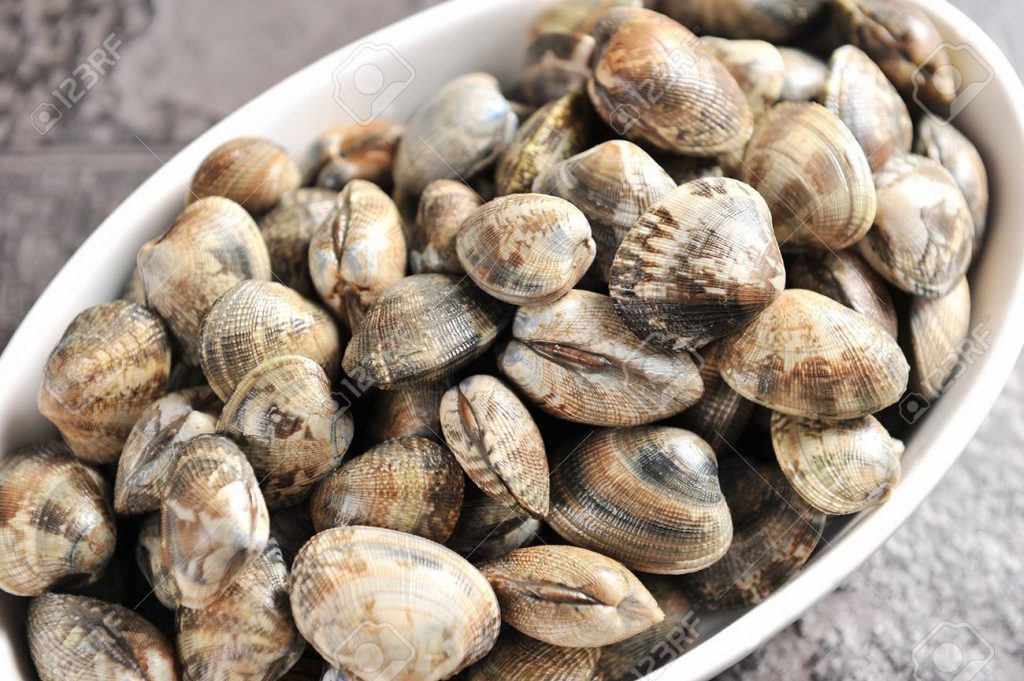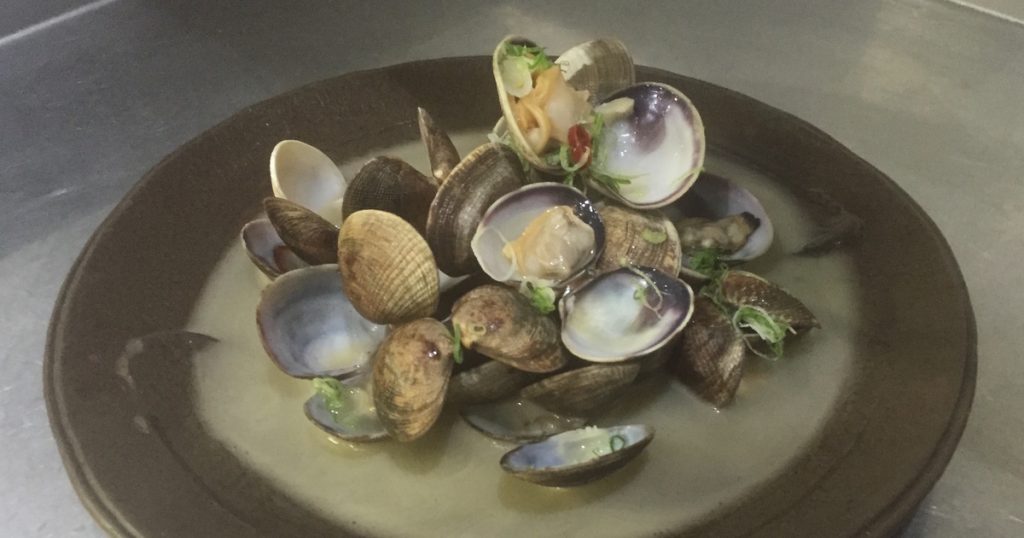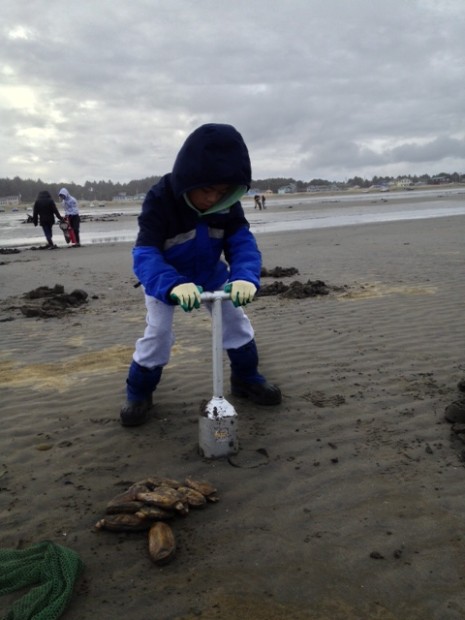Shellfish gathering is best kept winter secret as long as you don’t mind scouring the beaches in the dark Leave a reply

Break out of the winter doldrums by digging into a fun night-time affair happening right now on many local saltwater beaches.
The first thought in the lightbulb glowing above your head are coastal razor clams, but did you know there’s a bounty of other shellfish within a short drive from the greater Seattle area.
Finding public access on beaches in Puget Sound and Hood Canal are relatively easy and the good news is you’ll likely find some solitude and a nice bucket of clams or oysters to boot.
Before heading to a beach be sure to check the Washington Department of Fish and Wildlife (WDFW) and Department of Health (DOH) websites for any closures or changes. Also keep in mind that all eastern mainland beaches from Everett south into southern Puget Sound are also closed for shellfish due to unsafe pollution levels.
Here is a rundown of places you can check out that will have you bringing home some fresh steamer clams and oysters for the dining table.
In the northern reaches, Birch Bay State Park in Whatcom County – open year-round for shellfish – has an enhanced oyster beach and is also great for Manila and littleneck clams.
In Whatcom County, the Drayton West is open year-round and has oodles of Manila, native littleneck clams and butter clams with the best location near the north end of the beach. Remember the adjacent beach to the north is Semiahoo Marina and closed year-round due to pollution.
In Jefferson County, Shine Tidelands State Park, open through May 15, is an excellent for Manila, littlenecks and butter clams. Manila littleneck clams can be found over most of the mid-high intertidal zones. You can also find very good digging near the midpoint of the tidelands in the narrow band of sand/gravel that occurs fairly high on the beach.
In Hood Canal, Dosewallips State Park – open year-round for oysters – is excellent. The projected opening date for clams is June 15-Sept. 30 and you can find Manila littleneck clams in the mid-upper tidal zone in mixed sand and gravel substrate. Butter clams, cockles and horse clams can be found in the sandy areas below the oyster beds.

Eagle Creek near Lilliwaup off Highway 101 is exclusively an oyster gathering location which is open year-round. Due to a low population of clams it is closed except for a small window from June 1 to Aug. 31.
A mix of clams and oysters can be found at Point Whitney Lagoon and Tidelands. It is projected to remain open for clams and mussels through May 31, and for oysters through July 31.
Belfair State Park is open through May 31, located about three miles west of Belfair in Mason County, is an excellent oyster gathering spot, but not a good spot for clams.
In Kitsap County, Port Gamble Heritage Park Tidelands has a decent population of Manila clams, native littleneck clams, butter clams, horse clams and eastern soft-shell clams. Be aware of broken glass when digging and north end is great for historical glass for beach combers. The area also has a good patch of oyster beds. It is open for clams, mussels and oysters through May 31, and then projected to reopen from July 15 through Dec. 31.
Wolfe Property State Park, located just north of the Hood Canal Bridge, has an enhanced beach for clams and oysters (open through May 15). You’ll find good numbers of native littleneck clams and Manila littleneck clams. Some of the best clam digging occurs right in front of the access trail at the end of Seven Sisters Road. Butter clams are found in the lower intertidal zone and is an excellent beach for oysters, which receives regular oyster seeding with a boost from natural production.
Other Hood Canal beaches are Quilcene Bay Tidelands and is best known for Manila clam digging (open year-round with a 1 ½ inch minimum size for clams); Triton Cove State Park open year-round for clams and oysters; Triton Cove Tidelands open year-round for oysters only (open for clams June 1 through Aug. 31); Twanoh State Park open year-round for oysters only, and best spot is the west end of the park beach near the boat ramp in the “day use” portion of the park (projected to be open for clams Aug. 15 through Sept. 30); and West Dewatto is a small beach open year-round for oysters only and clams from July 1 through Sept. 30.
Unlike spring and summer shellfish gathering, low tides during the wintertime tend to occur in the dark of night. That means the most essential part of your gear isn’t just warm clothes and rain gear to wick away the wetness, but a powerful lantern coupled with a flashlight and headlamp.
Upcoming low tides – Jan. 21, minus-1.2 feet at 8:30 p.m.; Jan. 22, -1.6 at 9:13 p.m.; Jan. 23, -1.6 at 9:54 p.m.; Jan. 24, -1.5 at 10:33 p.m.; Jan. 25, -1.2 at 11:11 p.m.; Feb. 6, -1.4 at 8:44 p.m.; Feb. 7, -2.1 at 9:29 p.m.; Feb. 8, -2.4 at 10:14 p.m.; Feb. 9, -2.4 at 10:58 p.m.; Feb. 10, -1.8 at 11:43 p.m.; March 6, -1.0 at 8:17 p.m.; March 7, -1.4 at 9:07 p.m.; March 8, -1.4 at 10:54 p.m.; and March 9, -1.0 at 11:39 p.m. Day-by-day tides can be found by going to http://www.saltwatertides.com/dynamic.dir/washingtonsites.html.
Be sure to follow shellfish rules, daily limits, and gathering etiquette such as filling-in holes, shucking oysters and leaving the shells on the beach where you found them.
For a list of beaches open and/or closed, go to the WDFW website at
https://wdfw.wa.gov/fishing/shellfish/beaches/2019_ps_clam_oyster_seasons.pdf. An interactive map can be found at http://wdfw.wa.gov/fish/shelfish/beachreg.
For emergency beach closures, call the marine biotoxin hotline at 800-562-5632 or visit the DOH website at www.doh.wa.gov. Also check the WDFW hotline at 866-880-5431 and website at http://wdfw.wa.gov.
Shellfish gatherers age 16 to 69 must have a valid state-issued shellfish/seaweed harvesting license. A Discover Pass is required for parking in Washington State Parks and at undeveloped state park lands. Go to www.discoverpass.wa.gov.
Nibbles and bites
- The popular winter steelhead catch-and-release fishery on the Skagit and Sauk rivers won’t be open due to projected low returns.
WDFW projects 3,963 wild adult steelhead are expected to return to the Skagit Basin in 2020, which falls below the 4,000 fish threshold thus making the number of allowable impacts to those fish substantially restricted. Wild Puget Sound steelhead have been listed as threatened under the Endangered Species Act since 2007.
Most of steelhead returning are four- or five-year-old fish, and the dismal returns are likely the result of severe drought and low river flows in 2015 and 2016, and warm water conditions created by the “Blob” in the Pacific Ocean. The two rivers reopened for a brief catch-and-release fishery in 2018 and 2019.

- Dan Ayres, the head WDFW coastal shellfish manager, said crowds during the most recent digs were very small although when the weather cooperated just about everyone had their 15-clam daily limit. Next digs are Jan. 21, 23, 25; and Feb. 6, 8, 10, 12, 21 and 23 at Long Beach, Twin Harbors and Mocrocks; and Jan. 22, 24, 26; and Feb. 7, 9, 11, 20 and 22 at Long Beach, Twin Harbors and Copalis.
- Austin Moser, owner of Austin’s NW Adventures in Wenatchee, has been braving the bitter cold and reports the kokanee action on Lake Roosevelt has been on fire and the best fishing witnessed in the past four years. Kokanee and rainbow trout were averaging a whopping 19 inches and up to 22 inches. You can also find good bank angling for trout at the Keller Ferry Campground off Highway 21. Another option for kokanee although they’re much smaller in size is Lake Chelan.
- As this weather gets below freezing it’s also time to start looking at options for ice fishing on lakes especially places like Fish Lake and Roses Lake, and Curlew Lake. Be careful and make sure to not just head out without checking on ice thickness.
- Lastly, winter blackmouth fishing has been slow to fair at times in central Puget Sound (Marine Catch Area 10) – from Apple Tree Cove-Point Wells boundary line south to the northern tip of Vashon Island. Area 10 is open through March 31. South-central Puget Sound (11) is open through April 30 and Hood Canal (12) is open through April 30. Southern Puget Sound (13) is open year-round. Other choices on near horizon are the San Juan Islands (Area 7) open Feb. 1 through April 15; northern Puget Sound (Area 9) open Feb. 1 through April 15; and east side of Whidbey Island (Areas 8-1 and 8-2) open Feb. 1 through April 30. Keep in mind that getting out sooner than later is a wise idea since early closures hinge on catch guidelines or encounter limits for sub-legal and legal-size chinook.

